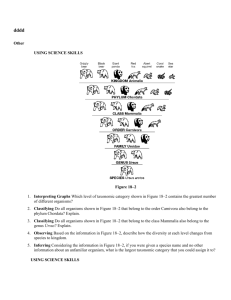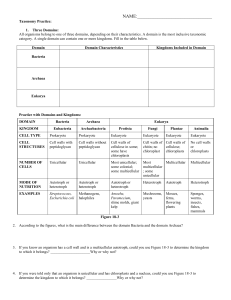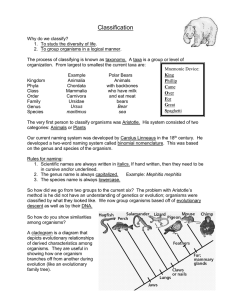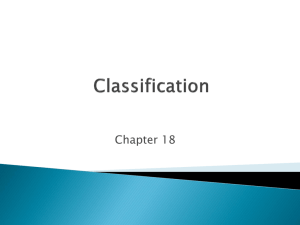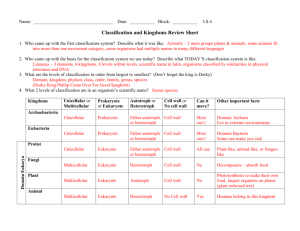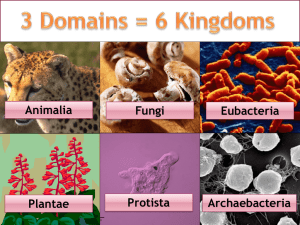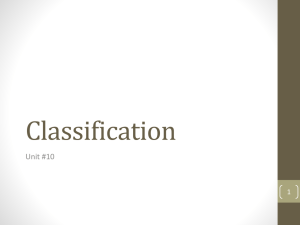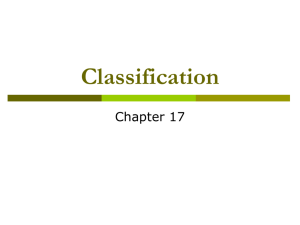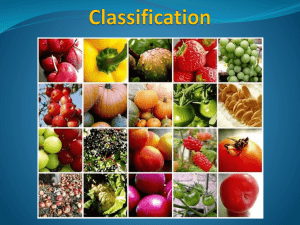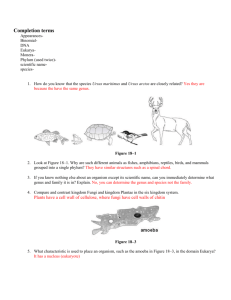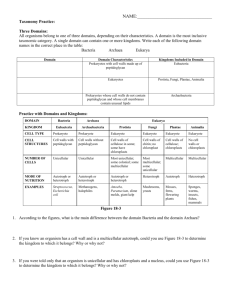Classification & Cell Structure Worksheet
advertisement
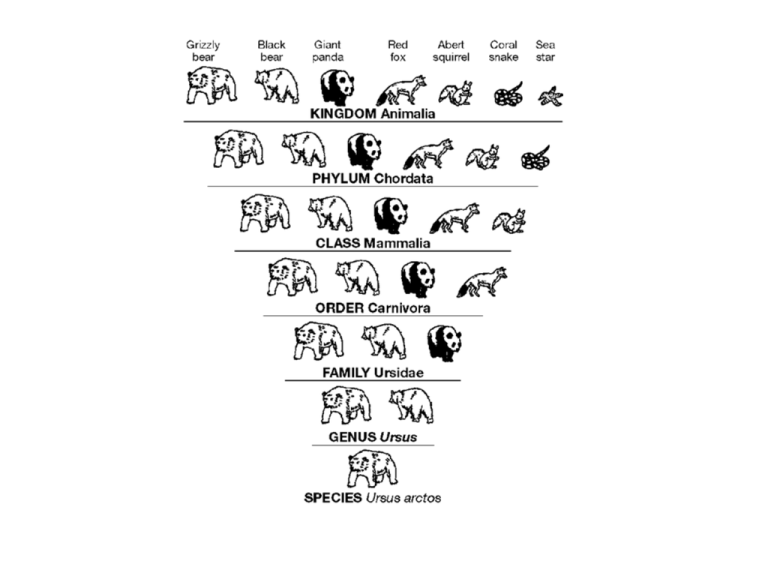
14. Interpret Graphs Which level of taxonomic category shown in Figure 18– 4 contains the greatest number of different organisms? 15. Classify Do all organisms shown in Figure 18–4 that belong to the order Carnivora also belong to the phylum Chordata? Explain. 16. Classify Do all organisms shown in Figure 18–4 that belong to the class Mammalia also belong to the genus Ursus? Explain. 17. Observe Based on the information in Figure 18–4, describe how the diversity at each level changes from species to kingdom. 18. Infer Examine Figure 18–4. In which group, Ursidae or Carnivora, would you expect the members to be more similar to one another? Explain your answer. Classification of Living Things DOMAIN KINGDOM Bacteria Archaea Eubacteria Archaebacteria Eukarya Protista Eukaryote Fungi Plantae Animalia Eukaryote Eukaryote Eukaryote No cell walls or chloroplasts CELL TYPE Prokaryote Prokaryote CELL STRUCTURE S Cell walls with peptidoglycan Cell walls without Cell walls of Cell walls of peptidoglycan cellulose in some; chitin some have chloroplasts Cell walls of cellulose; chloroplasts NUMBER OF CELLS Unicellular Unicellular Most unicellular; Most some colonial; multicellular; some multicellular some unicellular Most Multicellula multicellular; r some green algae unicellular MODE OF NUTRITION Autotroph or heterotroph Autotroph or heterotroph Autotroph or heterotroph Heterotroph Autotroph Heterotroph EXAMPLES Streptococcus, Escherichia coli Methanogens, halophiles Amoeba, Mushrooms, Paramecium, yeasts slime molds, giant kelp Mosses, ferns, flowering plants Sponges, worms, insects, fishes, mammals 19. Interpret Tables According to Figure 18–5, what is the main difference between the domain Bacteria and the domain Archaea? 20. Apply Concepts If you know an organism has a cell wall and is a multicellular autotroph, could you use Figure 18–5 to determine the kingdom to which it belongs? Why or why not? 21. Interpret Tables Can you determine, by examining Figure 18–5, which kingdom contains the greatest number of species? Why or why not? 22. Apply Concepts If you were told only that an organism is multicellular and lacks a cell wall, could you use Figure 18–5 to determine the kingdom to which it belongs? Why or why not? 23. Interpret Tables Considering the data presented in Figure 18–5, which characteristic seems more important in assigning an organism to a specific domain— the presence or absence of a nucleus or its mode of nutrition? Why? Classification of Four Organisms Corn Whale Shark Humpback Whale Spider Monkey Kingdom Plantae Animalia Animalia Animalia Phylum Anthophyta Chordata Chordata Chordata Class Monocotyledones Chondrichthyes Mammalia Mammalia Order Commelinales Squaliformes Cetacea Primates Family Poaceae Rhincodontidae Balaenopteridae Atelidae Genus Zea Rhincodon Megaptera Ateles Species Zea mays Rhinacodon typus Megaptera novaeangilae Ateles paniscus 24. Interpret Tables Which two organisms listed in Figure 18–6 are most closely related to each other? Explain. 25. Interpret Tables Which level of taxonomic category shown in Figure 18–6 indicates whether an organism is a mammal or not? 26. Interpret Tables How many different kingdoms are represented by the organisms listed in Figure 18–6? What are they? 27. Infer Consider the following statement: “Size and shape are NOT reliable indicators of how closely different organisms are related.” What information shown in Figure 18–6 supports this statement? Building A Cell What are the three main cell types? Learning Targets “I Can…” -Compare and contrast the three types of cells: plant, animal, and bacteria. -Distinguish between a prokaryotic and eukaryotic cell. -Distinguish between a plant and animal cell. -Draw/create a bacteria, plant, and animal cell and place the appropriate organelles in each cell type. Procedures 1. Cut out the cell parts and paste them in the cell in the proper location. 2. Label each cell part on the diagram. 3. Label the cell type (animal, plant, or bacteria.) 4. Label the cell as eukaryotic or prokaryotic. 5. Color the cell according to the key below: Cell Wall= Blue Cell Membrane= Yellow Cytoplasm= Pink 6. Create a Venn Diagram to show the similarities and differences of the three cell types.
